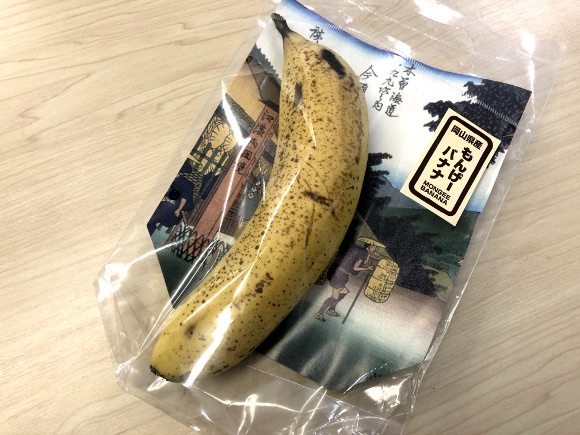
We get our hands on the mystical Mongee Banana.
If you’ve ever been to a Japanese department store in August, when they’re selling mid-year gifts, you’ll know that fruit can fetch some pretty high prices in Japan. High-end fruit can cost upwards of the equivalent of US$100, and at any time of the year, even basic grocery store fruit like apples and pears can, for certain varieties, cost $2 or $3 each. Nevertheless, fruit makes up a delicious part of Japanese food culture, but what would you think is the most consumed fruit in Japan?
The banana, of course! It’s no wonder since it’s easy to eat, cheap, and tasty. Japan imports 99 percent of their bananas from overseas, but part of the one percent that is produced in Japan is the Mongee Banana (pronounced “mon-gay”).
The Mongee Banana is a very special banana. It’s only grown in Okayama Prefecture, and they only sell 10 bananas per week. One banana costs 648 yen (about US$5.75), but the most interesting thing about this banana is that you can eat the skin!
We were able to get their hands on some of these bananas, so they gave them a taste test. What does an edible banana peel taste like? Let’s find out!
- About the mystical Mongee Banana
Mongee Bananas are produced at D&T Farm in Okayama Prefecture, in western Japan. Typically bananas only grow in tropical climates, but D&T Farms uses a method called “Freeze Thaw Awakening”, which extracts and implements the DNA of fruits in order to produce specimen similar to ancient times, which then allows them to be grown in a cooler climate. Bananas produced in this way were successfully grown for the first time in November.
Since they’re raised in a non-tropical climate, they don’t have any natural predators, which means no pesticides are used and Mongee Bananas are organically grown. They’re sweeter than regular bananas, with 24.8 grams of sugar, as opposed to the average 18.3 grams. Because of that, they’re also stickier and have a much stronger smell. That’s probably why they gave it the name “Mongee”, since “mongee” is Okayama slang for “incredible”.
You can only find Mongee Bananas in the Fruit Corner of Tenmanya Okayama, an Okayama department store. They only get one shipment per week of just 10 bananas, but they were generous enough to send us some for tasting.
- The first thing we noticed: The skin is very thin
Actually, before we could eat the bananas we had to wait for them to ripen. Apparently, they’re only ready to eat when you start to see little brown dots on the surface of the skin, unlike regular bananas, which are ripe before this stage. The Mongee Bananas took about two days after arrival to ripen. Meanwhile, the smell was getting stronger and more tempting.
Once it was ripe, Japanese-language correspondent P.K. Sanjun’s first inclination was to bite straight into the banana, but he suppressed his animal desires and first tried it like a regular banana. Upon peeling it he realized that the skin is relatively thin compared to a regular banana, so he thought it was reasonably edible-looking.
With a rising excitement he bit into the fleshy innards of the banana…and found it has a very strong tropical flavor. P.K. even said it’s almost pineapple-like, with a scent that just wafts right up through your nose to hit your taste buds. It’s definitely not a normal banana.
- The edible skin
Next the crew wanted to try the skin, so P.K. sliced up another banana with the skin still on. On the first bite we noticed that the skin is fairly easy to eat. Since it’s very thin, there’s no strange texture, and compared to the sweetness of the banana there isn’t much flavor to the skin. So the Mongee Banana truly does have an edible skin. Mongee!!
▼ Though some of our staff enjoyed it more than others.
▼ P.K. was the only one brave enough to just eat the skin…he said it was bitter, but not inedible. His face reveals his real thoughts about eating a banana peel, though.
To really understand how special the edible skin was, P.K. went to the convenience store and bought an ordinary banana, imported from Ecuador, with the intention of trying the skin. But that was a mistake…it was far too tough and fibrous, and the flavor was far more bitter and astringent. Conclusion: regular banana peels are not meant to be eaten. They might also be covered in pesticides, so we really don’t recommend eating them.
So let it be known, the Mongee Banana is definitely special! This top class, genetically enhanced, tropical-flavored banana is probably going to be difficult to get your hands on, but if you find yourself in Okayama, be sure to take a peek in Tenmanya. These bananas are really “mongee”. Oh, and in other strange food news, apparently dropping a raw egg in your coffee is a thing. Who knew?!
Images ©SoraNews24
[ Read in Japanese ]

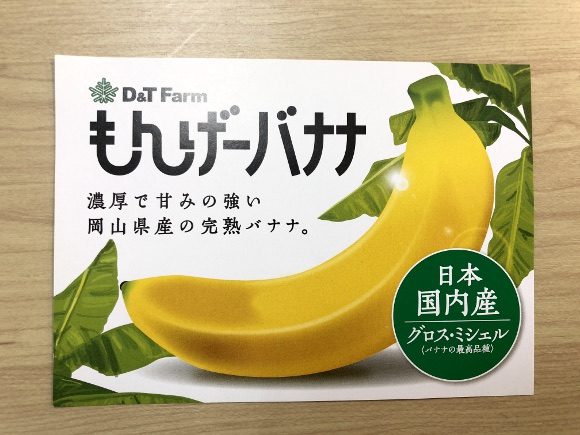

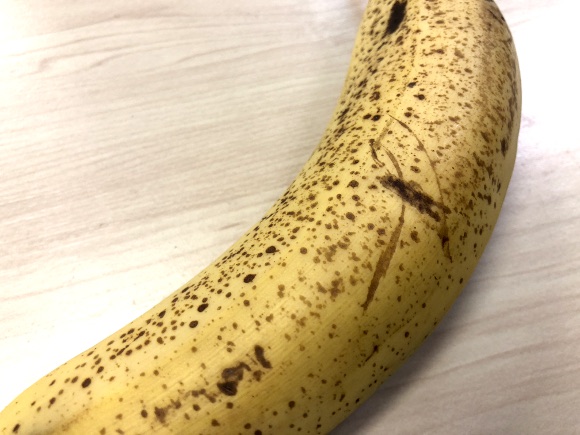
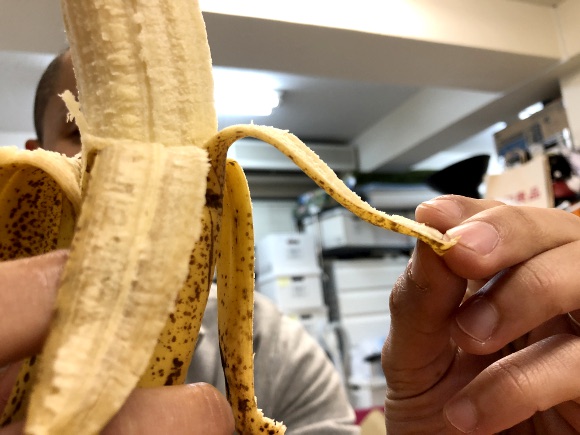
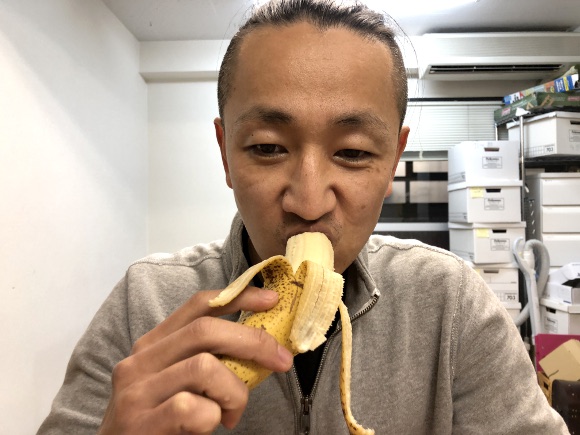
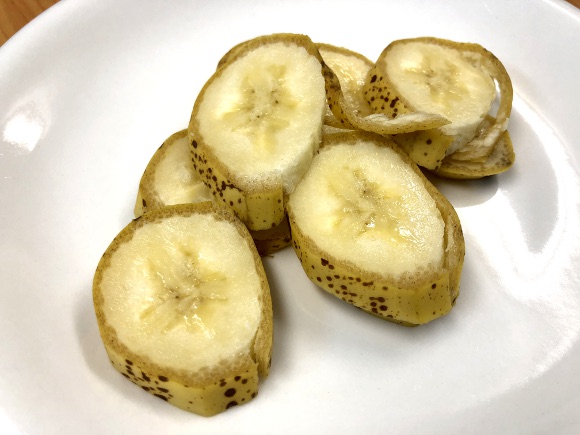
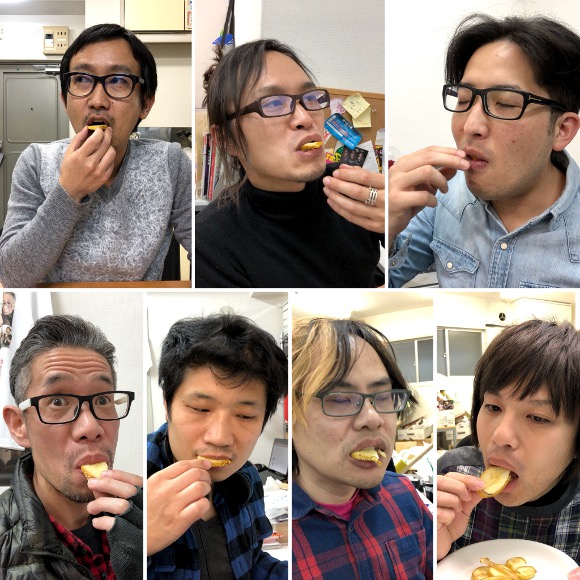
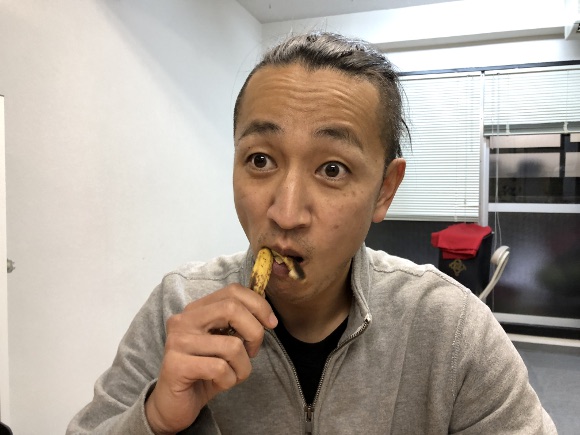
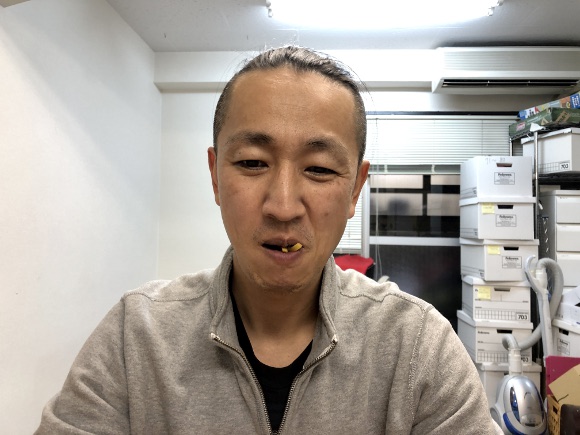
 In the evolution of pens, a “banana pen” is the obvious next step
In the evolution of pens, a “banana pen” is the obvious next step Dole Japan awarding personalised Banana Trophies to 200 runners in this year’s Tokyo Marathon
Dole Japan awarding personalised Banana Trophies to 200 runners in this year’s Tokyo Marathon Tokyo Banana Curry adds capital’s souvenir sweet’s sweetness to roux, but not in Tokyo
Tokyo Banana Curry adds capital’s souvenir sweet’s sweetness to roux, but not in Tokyo We’re going bananas over these amazing Attack on Titan…bananas!【Photos】
We’re going bananas over these amazing Attack on Titan…bananas!【Photos】 Need a whale-ly cool party idea? Make your own easy and fun banana dolphins! 【DIY】
Need a whale-ly cool party idea? Make your own easy and fun banana dolphins! 【DIY】 Japanese city loses residents’ personal data, which was on paper being transported on a windy day
Japanese city loses residents’ personal data, which was on paper being transported on a windy day Foreigner’s request for help in Tokyo makes us sad for the state of society
Foreigner’s request for help in Tokyo makes us sad for the state of society Should you add tartar sauce to Japanese curry rice? CoCo Ichi makes diners an unusual offer
Should you add tartar sauce to Japanese curry rice? CoCo Ichi makes diners an unusual offer Seaside scenery, history, and so many desserts on Yokohama’s Akai Kutsu【Japan Loop Buses】
Seaside scenery, history, and so many desserts on Yokohama’s Akai Kutsu【Japan Loop Buses】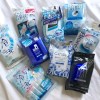 Japan’s cooling body wipe sheets want to help you beat the heat, but which work and which don’t?
Japan’s cooling body wipe sheets want to help you beat the heat, but which work and which don’t? Smash Bros. director Sakurai stabs Kirby in the face, has delicious justification for it
Smash Bros. director Sakurai stabs Kirby in the face, has delicious justification for it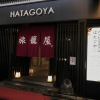 Tokyo capsule hotel’s low month-long rates are an awesome way to sample life in Japan’s capital
Tokyo capsule hotel’s low month-long rates are an awesome way to sample life in Japan’s capital With an Evangelion watch on your wrist, “all is right with the world.”
With an Evangelion watch on your wrist, “all is right with the world.” Akiba Dental Clinic: The Akihabara dentist where a moe maid in cosplay cleans your teeth
Akiba Dental Clinic: The Akihabara dentist where a moe maid in cosplay cleans your teeth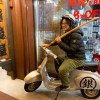 A Gintama fan’s emotional 19-year journey to buy a proper Lake Toya bokuto wooden katana【Pics】
A Gintama fan’s emotional 19-year journey to buy a proper Lake Toya bokuto wooden katana【Pics】 McDonald’s new Happy Meals offer up cute and practical Sanrio lifestyle goods
McDonald’s new Happy Meals offer up cute and practical Sanrio lifestyle goods Japanese ramen restaurants under pressure from new yen banknotes
Japanese ramen restaurants under pressure from new yen banknotes French Fries Bread in Tokyo’s Shibuya becomes a hit on social media
French Fries Bread in Tokyo’s Shibuya becomes a hit on social media Studio Ghibli releases new action figures featuring Nausicaä of the Valley of the Wind characters
Studio Ghibli releases new action figures featuring Nausicaä of the Valley of the Wind characters New private rooms on Tokaido Shinkansen change the way we travel from Tokyo to Kyoto
New private rooms on Tokaido Shinkansen change the way we travel from Tokyo to Kyoto Red light district sushi restaurant in Tokyo shows us just how wrong we were about it
Red light district sushi restaurant in Tokyo shows us just how wrong we were about it Tokyo Tsukiji fish market site to be redeveloped with 50,000-seat stadium, hotel, shopping center
Tokyo Tsukiji fish market site to be redeveloped with 50,000-seat stadium, hotel, shopping center All-you-can-drink Starbucks and amazing views part of Tokyo’s new 170 meter-high sky lounge
All-you-can-drink Starbucks and amazing views part of Tokyo’s new 170 meter-high sky lounge Beautiful Ghibli sealing wax kits let you create accessories and elegant letter decorations【Pics】
Beautiful Ghibli sealing wax kits let you create accessories and elegant letter decorations【Pics】 Studio Ghibli releases Kiki’s Delivery Service chocolate cake pouches in Japan
Studio Ghibli releases Kiki’s Delivery Service chocolate cake pouches in Japan New definition of “Japanese whiskey” goes into effect to prevent fakes from fooling overseas buyers
New definition of “Japanese whiskey” goes into effect to prevent fakes from fooling overseas buyers Our Japanese reporter visits Costco in the U.S., finds super American and very Japanese things
Our Japanese reporter visits Costco in the U.S., finds super American and very Japanese things Studio Ghibli unveils Mother’s Day gift set that captures the love in My Neighbour Totoro
Studio Ghibli unveils Mother’s Day gift set that captures the love in My Neighbour Totoro More foreign tourists than ever before in history visited Japan last month
More foreign tourists than ever before in history visited Japan last month New Pokémon cakes let you eat your way through Pikachu and all the Eevee evolutions
New Pokémon cakes let you eat your way through Pikachu and all the Eevee evolutions Sales of Japan’s most convenient train ticket/shopping payment cards suspended indefinitely
Sales of Japan’s most convenient train ticket/shopping payment cards suspended indefinitely Sold-out Studio Ghibli desktop humidifiers are back so Totoro can help you through the dry season
Sold-out Studio Ghibli desktop humidifiers are back so Totoro can help you through the dry season Japanese government to make first change to romanization spelling rules since the 1950s
Japanese government to make first change to romanization spelling rules since the 1950s Ghibli founders Toshio Suzuki and Hayao Miyazaki contribute to Japanese whisky Totoro label design
Ghibli founders Toshio Suzuki and Hayao Miyazaki contribute to Japanese whisky Totoro label design Doraemon found buried at sea as scene from 1993 anime becomes real life【Photos】
Doraemon found buried at sea as scene from 1993 anime becomes real life【Photos】 Tokyo’s most famous Starbucks is closed
Tokyo’s most famous Starbucks is closed One Piece characters’ nationalities revealed, but fans have mixed opinions
One Piece characters’ nationalities revealed, but fans have mixed opinions We asked a Uniqlo employee what four things we should buy and their suggestions didn’t disappoint
We asked a Uniqlo employee what four things we should buy and their suggestions didn’t disappoint Princesses, fruits, and blacksmiths: Study reveals the 30 most unusual family names in Japan
Princesses, fruits, and blacksmiths: Study reveals the 30 most unusual family names in Japan We try Starbucks Japan’s new tongue-twister Frappuccino
We try Starbucks Japan’s new tongue-twister Frappuccino Going Bananas for Bananart on Banana Day! Students create a “bananamation” movie【Video】
Going Bananas for Bananart on Banana Day! Students create a “bananamation” movie【Video】 Mister Donut teams up with master patissier for second round of luxurious, limited-edition donuts
Mister Donut teams up with master patissier for second round of luxurious, limited-edition donuts Time to go bananas for McDonald’s Japan’s chocolate banana smoothie and other new treats
Time to go bananas for McDonald’s Japan’s chocolate banana smoothie and other new treats Dole establishes Gokusen Day with 59 of their absolute finest serial numbered bananas
Dole establishes Gokusen Day with 59 of their absolute finest serial numbered bananas Japanese banana importer teaches us how to enjoy bananas and fight heatstroke at the same time
Japanese banana importer teaches us how to enjoy bananas and fight heatstroke at the same time Eat Eevee! Pokémon Tokyo Banana team-up enters round two with suggestions to freeze, singe Eevee
Eat Eevee! Pokémon Tokyo Banana team-up enters round two with suggestions to freeze, singe Eevee Japan now has a banana hammer made from a real banana…that’s not frozen
Japan now has a banana hammer made from a real banana…that’s not frozen Move over, Pikachu and Eevee — Piplup is here to take over Pokémon Tokyo Banana!
Move over, Pikachu and Eevee — Piplup is here to take over Pokémon Tokyo Banana! McDonald’s adds Doraemon exclusives to its menu in Japan【Taste test】
McDonald’s adds Doraemon exclusives to its menu in Japan【Taste test】 Starbucks Japan’s tongue-twister Frappuccino aims to bring smiles for summer…outside of summer
Starbucks Japan’s tongue-twister Frappuccino aims to bring smiles for summer…outside of summer New Starbucks Frappuccinos look and sound so good they drive us nuts even before going on sale!
New Starbucks Frappuccinos look and sound so good they drive us nuts even before going on sale! Starbucks Japan’s new banana chocolate pudding is so good we can’t keep our language clean
Starbucks Japan’s new banana chocolate pudding is so good we can’t keep our language clean Giant Pokémon huggy pillow is a dakimakura version of a sweet that’s too cute to eat【Photos】
Giant Pokémon huggy pillow is a dakimakura version of a sweet that’s too cute to eat【Photos】 Popular Japanese treat Tokyo Banana gets special makeover for baby panda’s debut at Ueno Zoo
Popular Japanese treat Tokyo Banana gets special makeover for baby panda’s debut at Ueno Zoo
Leave a Reply